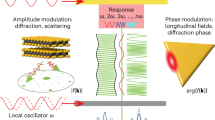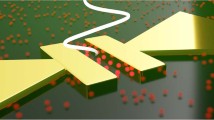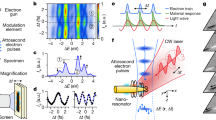Abstract
Multiple coherent scattering and the constructive interference of certain scattering paths form the common scheme of several remarkable localization phenomena of classical and quantum waves in randomly disordered media1. Prominent examples are electron transport in disordered conductors2,3, the localization of excitons in semiconductor nanostructures4,5, surface plasmon polaritons at rough metallic films6,7 or light in disordered dielectrics8,9,10,11 and amplifying media1,12,13,14. However, direct observation of the fundamental spatiotemporal dynamics of the localization process remains challenging15. This holds true, in particular, for the localization of light occurring on exceedingly short femtosecond timescales and nanometre length scales. Here, we combine second harmonic microscopy with few-cycle time resolution to probe the spatiotemporal localization of light waves in a random dielectric medium. We find lifetimes of the photon modes of several femtoseconds and a broad distribution of the local optical density of states, revealing central hallmarks of the localization of light.
This is a preview of subscription content, access via your institution
Access options
Subscribe to this journal
Receive 12 print issues and online access
$209.00 per year
only $17.42 per issue
Buy this article
- Purchase on Springer Link
- Instant access to full article PDF
Prices may be subject to local taxes which are calculated during checkout





Similar content being viewed by others
References
Abrahams, E. (ed.) 50 Years of Anderson Localization (World Scientific, 2010).
Belitz, D. & Kirkpatrick, T. R. The Anderson–Mott transition. Rev. Mod. Phys. 66, 261–380 (1994).
Richardella, A. et al. Visualizing critical correlations near the metal–insulator transition in Ga1–xMnxAs. Science 327, 665–669 (2010).
Hess, H. F., Betzig, E., Harris, T. D., Pfeiffer, L. N. & West, K. W. Near-field spectroscopy of the quantum constituents of a luminescent system. Science 264, 1740–1745 (1994).
Intonti, F. et al. Quantum mechanical repulsion of exciton levels in a disordered quantum well. Phys. Rev. Lett. 87, 076801 (2001).
Gresillon, S. et al. Experimental observation of localized optical excitations in random metal–dielectric films. Phys. Rev. Lett. 82, 4520–4523 (1999).
Stockman, M. I. Femtosecond optical responses of disordered clusters, composites, and rough surfaces: ‘the ninth wave’ effect. Phys. Rev. Lett. 84, 1011–1014 (2000).
Sapienza, L. et al. Cavity quantum electrodynamics with Anderson-localized modes. Science 327, 1352–1355 (2010).
Schwartz, T., Bartal, G., Fishman, S. & Segev, M. Transport and Anderson localization in disordered two-dimensional photonic lattices. Nature 446, 52–55 (2007).
Albada, M. P. V. & Lagendijk, A. Observation of weak localization of light in a random medium. Phys. Rev. Lett. 55, 2692–2695 (1985).
Wolf, P.-E. & Maret, G. Weak localization and coherent backscattering of photons in disordered media. Phys. Rev. Lett. 55, 2696–2699 (1985).
Wiersma, D. S., van Albada, M. P. & Lagendijk, A. Coherent backscattering of light from amplifying random media. Phys. Rev. Lett. 75, 1739–1742 (1995).
Cao, H. et al. Random laser action in semiconductor powder. Phys. Rev. Lett. 82, 2278–2281 (1999).
Fallert, J. et al. Co-existence of strongly and weakly localized random laser modes. Nature Photon. 3, 279–282 (2009).
Wang, J. & Genack, A. Z. Transport through modes in random media. Nature 471, 345–348 (2011).
Sheng, P. Introduction to Wave Scattering, Localization and Mesoscopic Phenomena (Springer, 2006).
Evers, F. & Mirlin, A. D. Anderson transitions. Rev. Mod. Phys. 80, 1355–1417 (2008).
Schreiber, M. & Grussbach, H. Multifractal wave functions at the Anderson transition. Phys. Rev. Lett. 67, 607–610 (1991).
Riboli, F. et al. Anderson localization of near-visible light in two dimensions. Opt. Lett. 36, 127–129 (2011).
Chabanov, A. A., Stoytchev, M. & Genack, A. Z. Statistical signatures of photon localization. Nature 404, 850–853 (2000).
Hu, H., Strybulevych, A., Page, J. H., Skipetrov, S. E. & van Tiggelen, B. A. Localization of ultrasound in a three-dimensional elastic network. Nature Phys. 4, 945–948 (2008).
Nieuwenhuizen, T. M. & van Rossum, M. C. W. Intensity distributions of waves transmitted through a multiple scattering medium. Phys. Rev. Lett. 74, 2674–2677 (1995).
Abrahams, E., Anderson, P. W., Licciardello, D. C. & Ramakrishnan, T. V. Scaling theory of localization: absence of quantum diffusion in two dimensions. Phys. Rev. Lett. 42, 673–676 (1979).
Djurišić, A. B. & Leung, Y. H. Optical properties of ZnO nanostructures. Small 2, 944–961 (2006).
Kitamura, K. et al. Fabrication of vertically aligned ultrafine ZnO nanorods using metal–organic vapor phase epitaxy with a two-temperature growth method. Nanotechnology 19, 175305 (2008).
Piglosiewicz, B. et al. Ultrasmall bullets of light-focusing few-cycle light pulses to the diffraction limit. Opt. Express 19, 14451–14463 (2011).
Stibenz, G. & Steinmeyer, G. Interferometric frequency-resolved optical gating. Opt. Express 13, 2617–2626 (2005).
Tritschler, T., Mücke, O. D., Wegener, M., Morgner, U. & Kärtner, F. X. Evidence for third-harmonic generation in disguise of second-harmonic generation in extreme nonlinear optics. Phys. Rev. Lett. 90, 217404 (2003).
Schmidt, S. et al. Distinguishing between ultrafast optical harmonic generation and multi-photon-induced luminescence from ZnO thin films by frequency-resolved interferometric autocorrelation microscopy. Opt. Express 18, 25016–25028 (2010).
Mirlin, A. D. Statistics of energy levels and eigenfunctions in disordered systems. Phys. Rep. 326, 259–382 (2000).
Acknowledgements
This research was supported by the Japan Science and Technology Agency (JST) and the Deutsche Forschungsgemeinschaft (DFG) within the ‘Nanoelectronics’ programme. The authors acknowledge support in Germany by the DFG (priority programme ‘Ultrafast nanooptics’, SPP 1391) and by the Korea Foundation for International Cooperation of Science & Technology (Global Research Laboratory project K20815000003). Support in Japan through a Grant-in-Aid for Young Scientists (A) from MEXT and a research grant (Basic Research) from The TEPCO Memorial Foundation is also acknowledged.
Author information
Authors and Affiliations
Contributions
C.L., E.R. and M.O. conceived the experiment. M.M. and S.S. carried out the measurements and analysed the data, together with M.S. and C.L. The samples were fabricated by K.K. and T.Y. FDTD simulations were performed by D.L. The manuscript was prepared by M.M., M.S., D.L., E.R. and C.L. All authors contributed to finalizing the manuscript.
Corresponding author
Ethics declarations
Competing interests
The authors declare no competing financial interests.
Supplementary information
Supplementary information
Supplementary information (PDF 1777 kb)
Rights and permissions
About this article
Cite this article
Mascheck, M., Schmidt, S., Silies, M. et al. Observing the localization of light in space and time by ultrafast second-harmonic microscopy. Nature Photon 6, 293–298 (2012). https://doi.org/10.1038/nphoton.2012.69
Received:
Accepted:
Published:
Issue Date:
DOI: https://doi.org/10.1038/nphoton.2012.69
This article is cited by
-
Nonlinear plasmon-exciton coupling enhances sum-frequency generation from a hybrid metal/semiconductor nanostructure
Nature Communications (2020)
-
Second harmonic generation hotspot on a centrosymmetric smooth silver surface
Light: Science & Applications (2018)
-
Anderson light localization in biological nanostructures of native silk
Nature Communications (2018)
-
Long-lived electron emission reveals localized plasmon modes in disordered nanosponge antennas
Light: Science & Applications (2017)
-
An electric field induced delocalization transition in second-harmonic generation effect
Optical and Quantum Electronics (2017)



